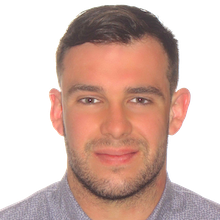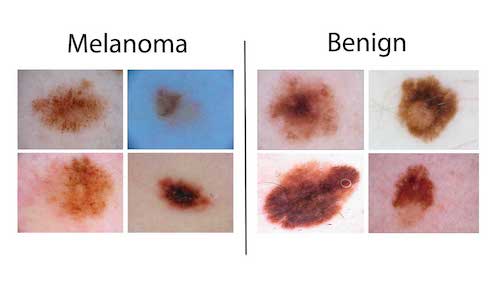 |
 |
 |
|---|---|---|
| Adria Romero-Lopez | Oge Marques | Xavier Giro-i-Nieto |
A joint collaboration between:
 |
 |
|---|---|
| UPC - Image Processing Group | FAU - College of Engineering and Computer Science |
The recent emergence of machine learning and deep learning methods for medical image analysis has enabled the development of intelligent medical imaging-based diagnosis systems that can assist physicians in making better decisions about a patient’s health. In particular, skin imaging is a field where these new methods can be applied with a high rate of success.
This thesis focuses on the problem of automatic skin lesion detection, particularly on melanoma detection, by applying semantic segmentation and classification from dermoscopic images using a deep learning based approach. For the first problem, a U-Net convolutional neural network architecture is applied for an accurate extraction of the lesion region. For the second problem, the current model performs a binary classification (benign versus malignant) that can be used for early melanoma detection. The model is general enough to be extended to multi-class skin lesion classification. The proposed solution is built around the VGG-Net ConvNet architecture and uses the transfer learning paradigm. Finally, this work performs a comparative evaluation of classification alone (using the entire image) against a combination of the two approaches (segmentation followed by classification) in order to assess which of them achieves better classification results.
Experimental results for the classification task are encouraging: on the ISIC Archive dataset, the proposed method achieves an accuracy in the top three of the best previously published results. The experimental results of the segmentation evaluations demonstrate that the proposed method can outperform other state-of-the-art models.
Keywords: Medical Image Analysis, Deep Learning, Medical Decision Support Systems,
Convolutional Neural Networks, Transfer Learning, Machine Learning, Melanoma, Dermoscopy, Skin Lesions,
Skin Cancer.
The recent emergence of deep learning methods for medical image analysis has enabled the development of intelligent medical imaging-based diagnosis systems that can assist the human expert in making better decisions about a patients health. In this paper we focus on the problem of skin lesion classification, particularly early melanoma detection, and present a deep-learning based approach to solve the problem of classifying a dermoscopic image containing a skin lesion as malignant or benign. The proposed solution is built around the VGGNet convolutional neural network architecture and uses the transfer learning paradigm. Experimental results are encouraging: on the ISIC Archive dataset, the proposed method achieves a sensitivity value of 78.66%, which is significantly higher than the current state of the art on that dataset.
This is a paper for the 13th IASTED International Conference [pdf]
Cite this publication with the following Bibtex code:
@inproceedings{lopez2017skin,
title={Skin lesion classification from dermoscopic images using deep learning techniques},
author={Lopez, Adria Romero and Giro-i-Nieto, Xavier and Burdick, Jack and Marques, Oge},
booktitle={Biomedical Engineering (BioMed), 2017 13th IASTED International Conference on},
pages={49--54},
year={2017},
organization={IEEE}
}
The impact of segmentation on the accuracy and sensitivity of a melanoma classifier based on skin lesion images.
This work investigates the hypothesis that segmentation improves classification performance of skin lesions using convolutional neural networks. Examination of classification using different degrees of segmentation on images from the ISIC Archive dataset with the VGG-16 architecture revealed unexpected results. Early results indicate that the highest classification performance occurs when a preclassification segmentation and an unconventional subsequent dilation of the segmentation region is performed.
This is a paper for the Society of Imaging Informatics for Medicine 2017 Annual Meeting [pdf] [slides]
Cite this publication with the following Bibtex code:
@inproceedings{burdick2017impact,
title={The impact of segmentation on the accuracy and sensitivity of a melanoma classifier based on skin lesion images},
author={Burdick, Jack and Marques, Oge and Romero-Lopez, Adri{\`a} and Gir{\'o} Nieto, Xavier and Weinthal, Janet},
booktitle={SIIM 2017 scientific program: Pittsburgh, PA, June 1-June 3, 2017, David L. Lawrence Convention Center},
pages={1--6},
year={2017}
}
| Participant | Rank | Accuracy | Dice | Jaccard | Sensitivity | Specificity |
|---|---|---|---|---|---|---|
| Ours | (1st)* | 0.9176 | 0.8689 | 0.9176 | 0.9301 | 0.9544 |
| Urko Sanchez | 1st | 0.953 | 0.910 | 0.843 | 0.910 | 0.965 |
| Lequan Yu | 2nd | 0.949 | 0.897 | 0.829 | 0.911 | 0.957 |
| Mahmudur Rahman | 3rd | 0.952 | 0.895 | 0.822 | 0.880 | 0.969 |
(*) Participants from the ISBI 2016 Challenge were ranked and awards granted based only on the Jaccard index.
| Method | Accuracy | Sensitivity | Precision |
|---|---|---|---|
| Unaltered lesion classification | 0.8469 | 0.8243 | 0.9523 |
| Perfectly segmented lesion classification | 0.8390 | 0.8648 | 0.9621 |
| Automatically segmented lesion class | 0.8174 | 0.8918 | 0.9681 |
In the field of Telecommunications Engineering 2016-2017.
Date: Jun 2018
Location: Barcelona, Spain.
 |
 |
|---|---|
| UPC | UPC Telefónica Catedra |
I would like to thank Albert Gil and Josep Pujal from our technical support team at the Image Processing Group at UPC.
 |
 |
|---|---|
| Albert Gil | Josep Pujal |
If you have any doubt about this work, please, do not hesitate to e-mail me at mailto:adriaromero@me.com or alternatively, reach me on Twitter.



